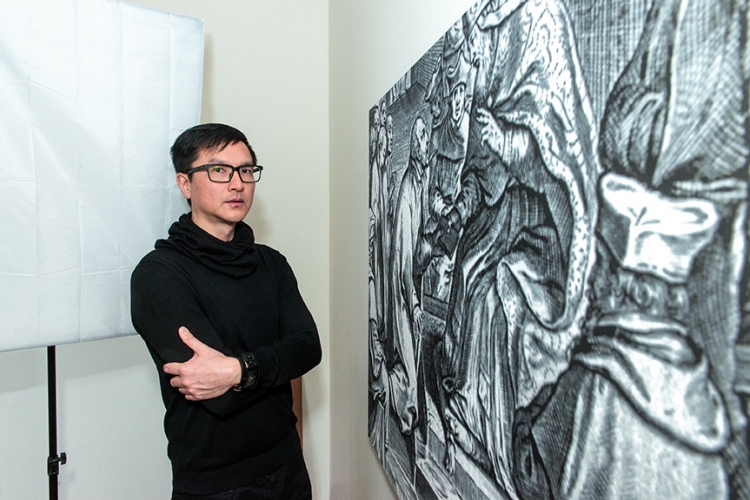
By
An interdisciplinary artist who practices mainly in drawing, painting and installation, Sammy Chong, SJ, is a visiting assistant professor in the Fine Arts Department. With an academic background in theology and philosophy, his studio practice builds on the notion of individual identity and transcendental meaning in contemporary society.
He has taught courses in the history of Christian Art, and theology and film, at Pontificia Universidad Catolica del Ecuador, after which he completed the MFA program at the School of the Museum of Fine Arts, Boston. Fr. Chong has exhibited in the US and South America, and has a studio in Jamaica Plain. His BC courses include Issues and Approaches to Studio Art; Drawing: Introduction to the Figure; The Art of Portraiture; Making Art through a Spiritual Lens, and Introduction to Painting. He serves as faculty advisor to the Art Club.
Fr. Chong discussed his latest work: a set of 12 paintings titled “The Pilgrim,” which depicts the journey of a modern man in search of his authentic self, for which he appropriates Baroque artist Peter Paul Rubens’ etchings of “The Life of Saint Ignatius of Loyola” to create a parallel narrative that follows one’s path from self-centeredness to a man for others. The works will be on display Nov. 2 through Dec. 4 as the inaugural exhibition in the new student and faculty gallery in Carney 203.
Q: What was your inspiration to recast Saint Ignatius of Loyola’s journey for today’s audience?
Throughout my Jesuit formation I saw many visual depictions of Ignatius of Loyola in books, paintings, sculptures, etchings, icons, stained glasses, and even stamps. I always felt I myself could portray him in a way that would do justice to his persona and his spiritual legacy. Ten years ago I decided to address this desire, yet the project never progressed beyond its sketching phase. I kept those drawings, which a decade later inspired the creation of “The Pilgrim” series. Even though the final project differs from its primal sketches, the stress on narrative remains. The story of Ignatius of Loyola is worth telling because he is an example to follow for anyone concerned with finding true meaning in life.
Q: What artistic challenges did that “recasting” present?
From the get-go I aimed to keep the past in conversation with the present and the future in this body of work. During the Renaissance, etchings became a novel visual medium in tandem with printmaking. Rubens received several commissions from the Jesuits in the early 17th century. Among them, the etchings he created of “The Life of Saint Ignatius of Loyola” made an impression on me when I saw them for the first time in a book long time ago.
Today, computer digital printing is continuously evolving and is intrinsic to our modern technological arsenal. To bridge the old with the new, I appropriated Rubens’ etchings and printed them on large canvas. These became the ground or surface on which I painted with oils. My painting approach also reflects the dialogue between past and present, by using traditional techniques along with compositions inspired in cinematography and graphic novels (or comic books), which are more attuned with modern sensibilities.
Q: Why is this journey relevant to today’s viewers, and what do you hope they take away from the exhibit?
It might sound cliché to address life as a journey, but we can only move forward, while learning from the past. It all comes down to the choices we make along the road that determine who we are as individuals. The challenge has always been to make the right decisions. Most of the time, we are unaware that our decisions are tarnished or conditioned by economic, political, religious, family, and personal concerns. In other words, we are not free. Ignatius of Loyola is relevant because he developed a technique in The Spiritual Exercises to achieve total freedom as we orient ourselves towards a greater cause.
Q: In what ways has your experience as a visiting professor at BC enriched you, both as an artist and a teacher/scholar?
I have embraced the liberal arts educational nature of BC. I appreciate BC’s multidisciplinary and integrative curriculum that pursues shaping students as well-rounded human beings. From this perspective, my teaching expands beyond skills and contents pertinent to students’ careers and touches other areas such as the spiritual, social justice, the environment, and so forth. I enjoy engaging in conversation with students, especially in informal settings such as the BC Art Club or over coffee. My practice as a visual artist has been informed by being professor in and outside the classroom inasmuch as I make art that is accessible to those reflecting upon their own journeys.
Q: How do you feel about your exhibit inaugurating the new Carney gallery?
I am grateful to have the opportunity to display my paintings in the new Carney gallery. My students and the larger community will have their first opportunity to view and respond to the work. I am positive that “The Pilgrim” is a solid and sound body of work that will enlighten students, professors, administrators and others.
(The Carney faculty and student gallery was created by the Arts Council and the Office of Student Involvement with the Office of Institutional Research, Planning & Assessment. Call ext.2-4935 for gallery hours.)



